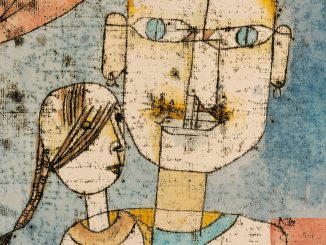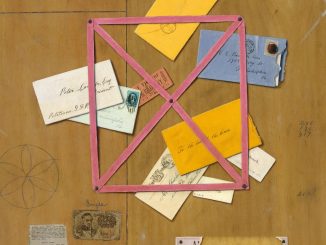
“Me oi, con muon xem em be!” I want to see, Mommy. I want to see the baby!
My son, Dylan, and I are on the 3rd floor of Kaiser Woodland Hills in medical exam room 29, which he has transformed into his personal playground. The wheeled office chair is his choo-choo, two gynecological cotton swabs have been turned into chopsticks, paper towels are crumpled into balls, and the foot pedal that turns on the sink—well, that’s just fun to stomp on. We are in this small room with Lydia, the same, patient midwife who delivered my son three years ago. She has known Dylan since he was a heartbeat on a fetal Doppler. Now he is a walking, talking little person with an agenda.
“Em be! Em be! Con muon xem em be!” The baby! The baby! I want to see the baby! Dylan hops up and down, trying to get a look. He’s barely eye level with the table where I lie gripping the edges, my bare feet in metal stirrups and chilly gel on my exposed belly. Lydia navigates around Dylan, a ballet of midwife and toddler, as she readies her equipment.
“Excuse me, handsome,” she guides him aside. Lydia is a trim, light-skinned African-American woman in her mid-50’s with warm, hazel eyes. Her quick, practiced movements match her efficient demeanor.
“Con muon xem! Con muon xem em be!” Dylan switches from Vietnamese to English, “I want to see, Mommy! I want to see the baby!” This is the highlight of today’s visit for my son. He’s even donned a special hat over his short, dark hair. It’s a warm, sunny L.A. day in the high 80’s, but Dylan is ready for a Chicago winter with his fuzzy fox hat. As he hops about, the hat’s pom-pom tassels bobble to and fro. Orange ear flaps frame his cheeks to make them look even chubbier. “Mommy, I want to see!” He buzzes from my belly to my face, belly-face-belly, never minding the stillness of my breath and bones.
“Okay, handsome” says Lydia. She pulls a chair next to the exam table where I lie. “Why don’t you climb up?” He clambers up, unaware of Lydia’s forearm close behind him, cupping him to safety. “Can you help me with this?” She holds out an ultrasound transducer, its head shaped like an electric razor. Dylan grabs it and Lydia repositions his hand, then places her hand over his to steer his movement. “Let’s see your sister.”
She puts the transducer head on my belly, squishing the gel. A murky image appears on the monitor which shifts and warps as Lydia manipulates the transducer back and forth, up and down, then sideways, sliding it. A few months before, the on-call OB had used a transvaginal ultrasound probe, almost the length of my femur, covered with a condom and cold lubricant, then pushed and prodded inside me. I had cringed until I heard it: the heartbeat. My baby girl.
This time, Lydia flicks her wrist and indents my stomach with the transducer head. Muddled sounds like wind on a microphone give way to a throbbing little pulse. “I see the baby, Mama! I see the baby! I see the baby!” Dylan crinkles the exam table paper as he reaches over to pat my belly. “Anh thay em!” Hi baby, I see you!
At this point, Dylan talks to the baby more often than my husband and I do combined. He even does show-and-tell with her by holding things up to my tummy. “This is my blue spoon,” he’ll say or “Look, I have a red car,” as he pushes one along my bulging mid-section. His comments are all sweetness except for once when he says, “This is my green crayon,” and then adds, “Dung co lay!” Don’t take it!
“Can we talk about C-sections?” I ask Lydia after the ultrasound. Dylan now has my iPhone and is absorbed in some game.
“Uh, sure.” Lydia peers at me over her bright yellow readers.
“It was very traumatic the last time,” I say, “I labored 32 hours, hemorrhaged, and had a fever—”
“It’s usually quicker and easier the second time,” Lydia moves her clipboard aside. She’s a midwife. Of course she advocates natural birth.
“Well,” I say, smoothing out the dressing gown’s wrinkles, “I was just wondering what the C-section policy is.”
“We only do them when there’s a health risk to the mother,” Lydia says, “like if the baby’s in a breech position—which yours isn’t. Or the mother is carrying multiples—which you aren’t. Or the mother has a heart disease that labor stress would affect.” Again, not me. “In cases of a healthy mom and baby, like yours—” she steers me back to the original plan.
On the floor, one of my silver sandals is shoved up against the exam table base, while the other sandal is upended. I look over at Dylan, tapping away on my phone, engrossed and oblivious.
“Lydia, it wasn’t just physically hard last time—” I stare at the small wheels on her office chair. One sticks out like a broken ankle. Lydia doesn’t say anything.
“I was sexually abused as a child.”
No reaction.
“So…a vaginal birth brings up a lot of trauma,” I say. “With Dylan—” my son is so captivated by his game, he doesn’t even look up at the mention of his name, “I was so…it was just…I couldn’t…” I shake my head. “I’m sorry, I can’t do it.”
Lydia reaches for my chart to check her notes. “Did we know this about you? When you had him?”
“Um…no.” I have spent weeks prepping for this conversation, but these are not questions I expected.
“Why not?”
My eyes go past Lydia to the speculum on the counter, the jar full of cervical swabs, and the box marked “towelette” full of obstetrical wipes. “I don’t know.”
I have no excuse. It’s not a secret. I talk openly about the abuse with partners, friends, therapists, co-workers, neighbors, hell—even strangers. It just never occurred to me to tell anyone involved with my actual medical care. Is that stupid? Lydia must think I’m an idiot.
“Honey, that’s remarkable if you gave birth vaginally.”
Huh?
Lydia explains that in her experience as a midwife, nearly all her patients who’ve been sexually abused can’t dilate. There’s some kind of block—all this anger and resentment wadded up in clenched cervixes. They won’t open up or release. Most end up having emergency C-sections. Many survivors are also unable to breastfeed because their milk won’t come in. “So,” she says, “I tip my hat to you for delivering naturally—”
“But I didn’t,” I say. “They gave me Pitocin.” Why is she congratulating me?
“That still counts,” she says. “Give yourself a hand. You must’ve done a lot of work on yourself to deliver that way.”
“Ye-es,” I say, but it’s not the credit I want, it’s the permission to have a C-section this time. I feel like a lab rat hitting yet another wall. How can I explain this so she gets it? So I can get it? Do I have to tell her about the night terrors I’ve been having again, in anticipation of this birth? What will it take?
I scan the room. Where’s a good scalpel when you need one? I am so desperate for her to understand that I would cut out my sex organ. Look at this cunt, I’d beseech her, is it bloody and ripped from being raped? Or from birthing a baby? Well for someone like me, it’s the SAME THING.
Instead I plead, “Lydia, when you’ve been sexually abused, having something forced down your—even if it’s your own baby coming out—it’s a painful echo of being raped. I know because I went through this the last time. I delivered vaginally. I know what happens. Please don’t make me do it again. It’s bad enough the abuse happened. Please don’t make me relive it. Not on the day I welcome my child to this world. That’s not how I want to meet my baby. Please let me have the C-section this time. Please. Please. PLEASE.”
Lydia shakes her head. “I’m sorry, it’s out of my hands,” she says. “You’ll have to talk to your OB.”
Dylan and I leave. His little fingers grip mine as we walk. I think back to the first time I held his tiny hand in mine—the day I had him. The “Boy A” tag on his hospital bracelet was wider than the palm of his hand.
During Dylan’s pregnancy, I’d watched “The Business of Being Born,” a documentary that convinced me to have an all-natural birth. I even considered an at-home birth, which my husband nixed because of possible complications from my advanced maternal age (at 39, Kaiser classified my pregnancy as “elderly”).
I completely bought into the belief that a vaginal birth was nobler and having one would somehow make me a better mother. After my water broke and I labored several hours with no change in dilation, the nurses kept offering interventions but I refused them all, clinging to that vaunted ideal of natural childbirth. I held out for over 20 hours—almost a full day of laboring before I finally accepted any drugs to further progress the labor. Even then, it took another half a day (12 hours) before my son was born.
For any first-time parent, caring for a newborn is a Herculean task. For me, it was even more grueling, having gotten no food or sleep for those 32 hours of labor, on top of the emotional wreck of reliving the childhood rape by my father. Then there was the physical recovery, not just from the birth but also from the hemorrhaging that happened both during and weeks after my delivery. And even after Dylan was born, I barely got any rest because my milk hadn’t come in, so on the advice of strident lactation consultants, I never slept more than three hours at a time, so I could get up to pump for 45 minutes on each side. I did this for months, despite getting no more than 3 oz of breastmilk a day—barely enough for one of his feeds—which made me feel horrible as a brand new, first-time mom. Here was proof I was physically incapable of nurturing my baby.
Dylan and I now turn down a corridor that leads to the parking lot. Every few steps, one side of the floor has blue tiles, while the other side has green tiles indicating separate paths to different hospital destinations. “I go on blue, Mommy. You go on green,” he says and pushes me away.
I reflect on what Lydia said about all those clenched cervixes unable to dilate. I tally my friends, and damnit if it isn’t true. My fellow survivors did, indeed, have emergency C-sections after laboring unsuccessfully for 20 hours or more. How many of them knew going in their unlikely odds of delivering vaginally?
Wouldn’t it have helped them to have known? So they could at least make an informed choice about their birthing options? Me personally, knowing what I know now, I still would have chosen to labor naturally, just not for as long. I would probably would have called it and accepted interventions well before the 20-hour mark. And I wouldn’t have killed myself trying to breastfeed, knowing the low likelihood of my actually producing enough milk.
Dylan and I reach the end of our colored tile trails by the parking lot. He sees a wadded up golden candy wrapper and steps on it, then kick it. He misses. “Dylan,” I say, calling him into the glass-walled elevator that overlooks the hospital driveway.
“What number?” he asks.
I hold up three fingers and say, “Knuckle.”
He complies, using his knuckle to push the “3” button instead of his finger.
What are the statistics on women who’ve been sexually abused? Twenty percent in the U.S.? So one out of every five women entering the delivery room will likely have birthing complications because of her abuse? That’s about 800,000 women in the U.S. each year. Shouldn’t these women be warned beforehand so they can prepare? There should be more information out there about this. It should be standard procedure to counsel these women about how their traumatic pasts may affect their labor. How many of these women, like me with my firstborn, won’t know what to expect?
Well, this time I do know.
Here I am with a beautiful son and a wonderful husband, about to welcome a little girl. We are just beginning to grow our family. This should be a happy time. Instead, there are still reverberations from what my father did to me over 35 years ago. And even though I will eventually be granted permission to have a C-section, on the day I meet my newborn daughter I will still have to contend with a slew of humiliations because of standard operating hospital policies.
Every medical professional I come across the day she is born will make me repeat my full name, birth date, and explain why I am having a C-section when I’ve been able to birth vaginally. “I was sexually abused,” I’ll have to say, over and over and over and over and over to the nurse who assigns my bed, the admin who comes by with forms to sign, the technician who puts in the IV, the head nurse when she stops by, the new nurse when there is a shift change. I will keep having to repeat myself, “I was sexually abused…I was sexually abused…I was sexually abused,” even though it is clearly in my medical notes why I am not giving vaginal birth this time—medical notes which no one will bother to read. And while yes, I’ve discussed my abuse with strangers before, this will be different because it won’t be a conversation, it won’t be a choice to share and give and take, it will be a clinical recitation of information—I was raped by my father—that will be used to categorize me just like my advanced maternal age, blood type and family history of diabetes.
At the start of the actual procedure I have fought to have, my husband will not be allowed in the OR. I will be naked from the waist down and alone as a curtain is placed to split off the top half of my body from seeing the bottom half. The OB will warn me that I’ll be injected with something that will numb my legs. However, no manner of advance notice will prepare me for the horrible flashback of a slow, dulling sensation overtaking me from the waist down as I feel foreign hands pushing, poking and prodding my body. I will be stricken with panic, start crying, and then I will scream. I will scream for help. I will scream for my husband who isn’t allowed to be there yet. I will scream for more drugs to knock me out. I will scream and scream and scream and scream. I will scream until I am unconscious, a total blackout while I am cut open, while my daughter is delivered, while my husband is finally allowed in, and while the terror fades. I will be dead to the world until I hear another scream—the tiny wail of my daughter, announcing her arrival into this world.
AUTHOR

Lan Tran
Lan Tran’s work has previously been anthologized in A New Literary History of America (Harvard University Press, 2009) and Waking Up American (Seal Press, 2005). She is the recipient of the PEN/Rosenthal Emerging Voices Fellowship and also the writer/performer of three off-Broadway solo shows.
Twitter: @WordDoyenne
Featured image: From Eugène Grasset’s book, Plants and Their Application to Ornament, 1896.


